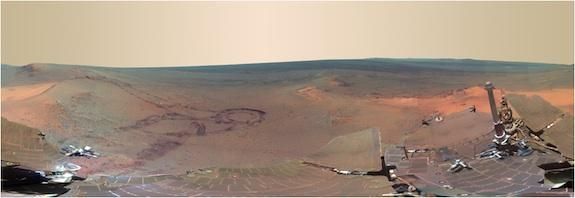Mars Day Preview with Geologist Dr. John Grant
Get ready for Air and Space Museum’s Mars Day July 13 with geologist Dr. John Grant discussing findings, The Martian Chronicles and why he loves Mars Day
/https://tf-cmsv2-smithsonianmag-media.s3.amazonaws.com/filer/20120711061012Mars-Day_Thumbnail.jpg)
Dr. John Grant likes to say that it is just no big deal that he has control of the Mars rover on his desktop computer. He will tell you that a whole team of people has access to the rover. But still, that leaves out a lot of us who don’t.
This Friday, aspiring space explorers will have a chance to talk with Grant and other scientists about what they’ll argue is the greatest planet in the solar system, Mars. Though Mars Day honors the first spacecraft ever to land on Mars, Viking 1, back in 1976; this year it also marks the upcoming August 6 landing of Curiosity, the newest rover.

Though there isn’t a joystick or live feed from the rover, Grant is still able to send out a series of commands (timed to coordinate with the rotations of the satellites orbiting Mars) to guide the rover as his team explores the planet. On Wednesday, Grant will be preparing commands directing the rover to Mt. Goldsworthy, which is not a mountain at all, but a deep crack in the surface.
He’s been in love with the red planet ever since he read Ray Bradbury’s The Martian Chronicles. Trained as a geologist, Grant studies the mineral makeup of Mars to learn more about the forces that transformed the planet over billions of years. He spoke with ATM about his recent research and why he loves Mars Day.
You recently co-authored a paper on alluvial fan formations on the surface of Mars possibly formed by snow, how does this change our understanding of Mars?
It says that things were happening on Mars, in terms of water on the surface, more recently than a lot of folks had thought about in the past. It’s not like these things are suggesting that Mars was like the Amazon rainforest relatively late in its history, it was still cold and relatively dry compared to what we think about here on Earth, but that things probably were happening later in Mars’ history, things from running water–albeit from melting snowfall–than we’d really thought about earlier.
Why does everyone get so excited when we’re talking about water or snow, what are the possibilities?
Water is very important in terms of establishing habitable conditions and providing some of the kinds of habitats that might be needed for life. There used to be a mantra among the Mars program, “Follow the water,” that’s sort of evolved into “Was Mars habitable?” because we’ve sort of seen now what the role of water has been. Although, this paper that I just described, is still sort of changing our perspective a little bit.
So how do you answer that question, is Mars habitable?
It looks like it certainly was in some places in the past. We’re sending our science laboratory there, which is arriving in about four weeks, to try to evaluate that a little more comprehensively. But there’s evidence that there were standing bodies of water; that there was water flowing on the surface; that, relative to what we see today, Mars in its earliest history at least was much wetter, maybe more clement, more Earth-like in some regards than it is today.
You fell in love with Mars after reading The Martian Chronicles. What did you imagine Mars to be like when you were young?
When I was a little kid and I really didn’t know any better, The Martian Chronicles really captured my imagination because it was this idea that you could have a place that was different, but in some ways similar. And Mars hasn’t disappointed in that regard. There are a lot of scenes that we’ve taken with the rovers, Opportunity and Spirit, it looks for all the world like the Mojave Desert, minus a few sage brush and grasses. But it’s different, there are other things that make you say, “That’s not quite right.” The life part hasn’t played forward yet, but it still is a key interest and something that I’d like to find out or see others find out before I retire.

Why is Mars the best planet?
It’s one that’s very intriguing because the processes that have shaped the surface in many ways are the same as on the Earth. There have been a lot of craters formed on the Earth but because of plate tectonics, because of more erosion, the signature of those has been erased. So when we see Mars, we see a planet with the same processes, different emphasis and we see a surface that has been preserved from three to four billion years ago. And that record’s not really preserved on the Earth. We’re sort of looking back in time and I think that’s why it’s so special.
What is your favorite part of Mars Day?
Mars Day is great, I think, because it allows, especially kids, but people of all ages, to come in and really discover something about Mars. To me, it’s kind of like that same experience that I had of reading The Martian Chronicles. You’ll see a small child have a look at something on Mars and they’ll start to make discoveries themselves. Not only does that peak their interest in planetary geology and Mars but it also gets them thinking about science, which I think is really important.
–––
Mars Day visitors can view Viking 1, a 3-D, HD image of the planet’s surface and a Mars meteorite. Test your knowledge with a Red Planet Quiz Show and try your hand at maneuvering robots. Events take place at the Air and Space Museum July 13 and run from 10:00 to 3:00.
/https://tf-cmsv2-smithsonianmag-media.s3.amazonaws.com/accounts/headshot/Leah-Binkovitz-240.jpg)
/https://tf-cmsv2-smithsonianmag-media.s3.amazonaws.com/accounts/headshot/Leah-Binkovitz-240.jpg)